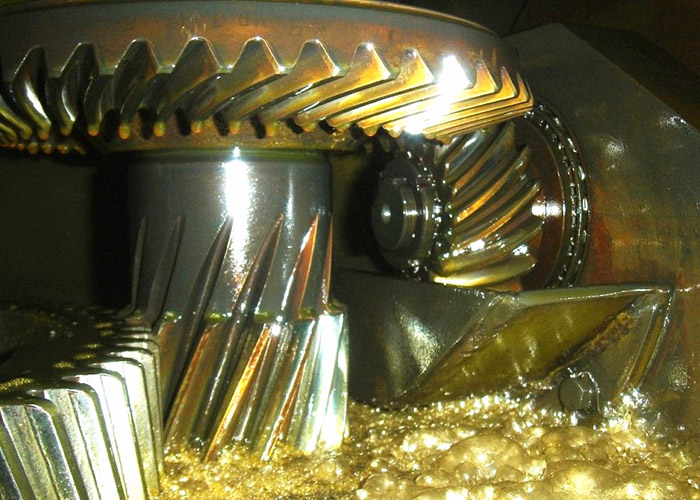You have abnormal foaming of oil in a gearbox
 Lubricating oils are not completely free of air. Whether during operation or storage in barrels, oils are constantly in an exchange process with their air-containing environment. Even if the oil is free of air bubbles, it will have a proportion of dissolved air. This depends primarily on the gas solubility, but pressure and temperature also have an effect. Some mineral oils can have air content approaching 9 to 11 percent volume at atmospheric pressure and room temperature. As long as the air remains dissolved in the oil, this generally is not a problem. However, free air bubbles, which usually are caused by constantly immersing machine parts or through oil returning to the reservoir, can lead to serious disruptions in equipment operation, including impaired cooling effect, increased oxidation tendency, shortened oil life, reduced carrying capacity of the lubricant film, oil spills, decreased oil pump capacity, lack of lubrication, cavitation and micro dieseling. Air release cannot be improved by additives. However, the foaming behaviour of lubricating oils can be improved by anti-foam additives, which reduce the surface tension of the oil, i.e., by the well-proportioned addition of silicon - containing compounds or oil - soluble polyglycols.
Lubricating oils are not completely free of air. Whether during operation or storage in barrels, oils are constantly in an exchange process with their air-containing environment. Even if the oil is free of air bubbles, it will have a proportion of dissolved air. This depends primarily on the gas solubility, but pressure and temperature also have an effect. Some mineral oils can have air content approaching 9 to 11 percent volume at atmospheric pressure and room temperature. As long as the air remains dissolved in the oil, this generally is not a problem. However, free air bubbles, which usually are caused by constantly immersing machine parts or through oil returning to the reservoir, can lead to serious disruptions in equipment operation, including impaired cooling effect, increased oxidation tendency, shortened oil life, reduced carrying capacity of the lubricant film, oil spills, decreased oil pump capacity, lack of lubrication, cavitation and micro dieseling. Air release cannot be improved by additives. However, the foaming behaviour of lubricating oils can be improved by anti-foam additives, which reduce the surface tension of the oil, i.e., by the well-proportioned addition of silicon - containing compounds or oil - soluble polyglycols.
Too many anti-foam additives can lead to a significant deterioration of the air-release capability. It is always a good practice to consult your lubricant supplier first for advice.
Symptoms
Foam is a collection of small bubbles of air that accumulate on or near the surface of the fluid. In severe cases, the foam can leak out of the machine through breathers, sight glasses and dipsticks.
Foam is an efficient thermal insulator, so the temperature of the oil can become difficult to control.
Foam is an object formed by trapping pockets of gas in a liquid or solid. A bath sponge and the head on a glass of beer are examples of foams. In most foams, the volume of gas is large, with thin films of liquid or solid separating the regions of gas.
Foam and Air Release
Oil returning to a reservoir has enough time to separate air in the form of air bubbles. The main influences on the speed at which these air bubbles separate from the oil and rise include the size of the bubbles, the oil’s viscosity and the oil temperature. The amount of dispersing additives, the oil’s density and any impurities also play a role. As air bubbles arrive at the surface, surface foam is formed. Therefore, foam consists of a series of air bubbles, which are each surrounded by a skin of oil. As a function of the oil’s surface tension, this skin of oil can burst more or less rapidly. The time it takes for the ascended bubbles to burst and achieve complete separation from the oil is mostly dependent on the oil’s viscosity and temperature, but the content of polar aging products, impurities and certain additives also have a bearing. The oil property that describes how fast these ascended bubbles burst is called the foaming behaviour.
Operational Causes of Foaming
The possible causes of foam formation in gearbox can be divided into two groups: transmission and lubricating oil. If lubricating oil mixes with other lubricants or contaminants such as dust or water, foaming can result along with oil aging, which leads to the formation of polar oil-aging products, an increase in viscosity or filtering out of anti-foam additives by bypass filters. In practice, you often see an overlap of several factors. While each factor on its own would not be a problem, a combination of these factors can lead to increased foaming. This makes it difficult to identify the actual causes.
Flender Foam Test
The measurement of foaming characteristics according to Flender is standardized in ISO/DIS 12152. Flender has developed special test and standardized. This test delivers much more reliable results and can improve www.machinerylubricationindia.com the reliability of gear oils. The examples given demonstrate the application of these test procedures and offer an overview of foaming problems as well as their cause. The upper limit of more than a 15-percent increase in the oil volume one minute after stopping the instrument does not equate to an actual foaming limit for existing gearboxes. This limit is only valid for the test instrument and the standardized test procedure. It is based on the experiences of Siemens (Flender) in meeting the requirements of Flender gearboxes. Some filter manufacturers have even included the Flender foam test in their testing procedures to avoid problems with removed anti-foam agents.
